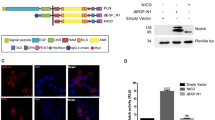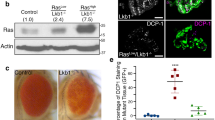Abstract
The Notch genes of C. elegans, Drosophila melanogaster and vertebrates encode receptors responsible for cell fate decisions during development. These Notch receptors and their ligands, Delta and Jagged, have been implicated in several human diseases. Truncated, constitutively active mutant forms of the Notch receptor appear to be involved in human T-cell leukemia, mammary carcinomas in mice, and a tumorous germline phenotype in C. elegans. Since activated Notch induces solitary tumors in transgenic mice, it is highly likely that collaborating genetic events are required for tumor formation. We have assessed four signal transduction pathways to determine which might play additional roles in malignant transformation in concert with activated Notch4. Our results suggest that transformation by Notch does not, as might have been expected, depend on the Src-like kinases Lck and Fyn, nor upon signals from protein kinase A and C (PKA, PKC). Rather, transformation by Notch requires active signals from the Erk/MAP kinase and PI-3 kinase pathways downstream of Ras.
This is a preview of subscription content, access via your institution
Access options
Subscribe to this journal
Receive 50 print issues and online access
$259.00 per year
only $5.18 per issue
Buy this article
- Purchase on Springer Link
- Instant access to full article PDF
Prices may be subject to local taxes which are calculated during checkout





Similar content being viewed by others
References
Amundadottir LT and Leder P. . 1998 Oncogene 16: 737–746.
Beitel GJ, Tuck S, Greenwald I and Horvitz HR. . 1995 Genes Dev. 9: 3149–3162.
Capobianco AJ, Zagouras P, Blaumueller CM, Artavanis-Tsakonas S and Bishop JM. . 1997 Mol. Cell Biol. 17: 6265–6273.
Davidson NE and Kennedy MJ. . 1996 Cancer Treat. Res. 83: 91–105.
Dudley DT, Pang L, Decker SJ, Bridges AJ and Saltiel AR. . 1995 Proc. Natl. Acad. Sci. USA 92: 7686–7689.
Ellisen LW, Bird J, West DC, Soreng AL, Reynolds TC, Smith SD and Sklar J. . 1991 Cell 66: 649–661.
Fortini ME, Rebay I, Caron LA and Artavanis-Tsakonas S. . 1993 Nature 365: 555–557.
Girard L, Hanna Z, Beaulieu N, Hoemann CD, Simard C, Kozak CA and Jolicoeur P. . 1996 Genes Dev. 10: 1930–1944.
Graus-Porta D, Beerli RR and Hynes NE. . 1995 Mol. Cell Biol. 15: 1182–1191.
Greenwald I. . 1998 Genes Dev. 12: 1751–1762.
Hanke JH, Gardner JP, Dow RL, Changelian PS, Brissette WH, Weringer EJ, Pollok BA and Connelly PA. . 1996 J. Biol. Chem. 271: 695–701.
Hennipman A, van Oirschot BA, Smits J, Rijksen G and Staal GE. . 1989 Cancer Res. 49: 516–521.
Jacobs C and Rubsamen H. . 1983 Cancer Res. 43: 1696–1702.
Jhappan C, Gallahan D, Stahle C, Chu E, Smith GH, Merlino G and Callahan R. . 1992 Genes Dev. 6: 345–355.
Joutel A and Tournier-Lasserve E. . 1998 Semin. Cell. Dev. Biol. 9: 619–625.
Kopan R, Nye JS and Weintraub H. . 1994 Development 120: 2385–2396.
Kopan R, Schroeter EH, Weintraub H and Nye JS. . 1996 Proc. Natl. Acad. Sci. USA 93: 1683–1688.
Kuriyama M, Harada N, Kuroda S, Yamamoto T, Nakafuku M, Iwamatsu A, Yamamoto D, Prasad R, Croce C, Canaani E and Kaibuchi K. . 1996 J. Biol. Chem. 271: 607–610.
Levitan D and Greenwald I. . 1998 Development 125: 3101–3109.
Lieber T, Kidd S, Alcamo E, Corbin V and Young MW. . 1993 Genes Dev. 7: 1949–1965.
Matsuo T, Takahashi K, Kondo S, Kaibuchi K and Yamamoto D. . 1997 Development 124: 2671–2680.
Miller DT and Cagan RL. . 1998 Development 125: 2327–2335.
Miyamoto H, Nihonmatsu I, Kondo S, Ueda R, Togashi S, Hirata K, Ikegami Y and Yamamoto D. . 1995 Genes Dev. 9: 612–625.
Nishizuka Y. . 1986 Science 233: 305–312.
Nishizuka Y. . 1988 Nippon Ketsueki Gakkai Zasshi 51: 1321–1326.
Ordentlich P, Lin A, Shen CP, Blaumueller C, Matsuno K, Artavanis-Tsakonas S and Kadesch T. . 1998 Mol. Cell. Biol. 18: 2230–2239.
Ottenhoff-Kalff AE, Rijksen G, van Beurden EA, Hennipman A, Michels AA and Staal GE. . 1992 Cancer Res. 52: 4773–4778.
Pear WS, Aster JC, Scott ML, Hasserjian RP, Soffer B, Sklar J and Baltimore D. . 1996 J. Exp. Med. 183: 2283–2291.
Platet N, Prevostel C, Derocq D, Joubert D, Rochefort H and Garcia M. . 1998 Int. J. Cancer 75: 750–756.
Price JV, Savenye ED, Lum D and Breitkreutz A. . 1997 Genetics 147: 1139–1153.
Reed JC. . 1999 Curr. Opin. Oncol. 11: 68–75.
Struhl G and Adachi A. . 1998 Cell 93: 649–660.
Struhl G, Fitzgerald K and Greenwald I. . 1993 Cell 74: 331–345.
Sundaram M and Han M. . 1996 Bioessays 18: 473–480.
Takahashi I, Kobayashi E, Asano K, Yoshida M and Nakano H. . 1987 J. Antibiot (Tokyo) 40: 1782–1784.
Tamaoki T and Nakano H. . 1990 Biotechnology (NY) 8: 732–735.
Tanyi J, Tory K, Bankfalvi A, Shroder W, Rath W and Fuzesi L. . 1999 Pathol. Oncol. Res. 5: 90–94.
Toullec D, Pianetti P, Coste H, Bellevergue P, Grand-Perret T, Ajakane M, Baudet V, Boissin P, Boursier E, Loriolle F et al. 1991 J. Biol. Chem. 266: 15771–15781.
Uyttendaele H, Marazzi G, Wu G, Yan Q, Sassoon D and Kitajewski J. . 1996 Development 122: 2251–2259.
Vlahos CJ, Matter WF, Hui KY and Brown RF. . 1994 J. Biol. Chem. 269: 5241–5248.
Weinmaster G. . 1997 Mol. Cell. Neurosci. 9: 91–102.
Wilkinson HA and Greenwald I. . 1995 Genetics 141: 513–526.
Acknowledgements
We thank Drs Laufey Amundadottir for advice on chemical treatment and soft agar assays, Robert Cardiff for pathology, Robert Callahan for MMTV-activated-Notch4, Lewis Cantley for DN-PI3 kinase, Juanita Torres and Dov Schwartz for cell cycle assistance. Susan Macdonald for Dn-Mek, David Dudley, Parke-Davis Pharmaceutical Research Division for UCN-01 and Drs Benedict Vollrath and Pamela Carroll for critical reading of this manuscript. K Fitzgerald was supported by a fellowship from the Leukemia Society of America during aspects of this work.
Author information
Authors and Affiliations
Rights and permissions
About this article
Cite this article
Fitzgerald, K., Harrington, A. & Leder, P. Ras pathway signals are required for notch-mediated oncogenesis. Oncogene 19, 4191–4198 (2000). https://doi.org/10.1038/sj.onc.1203766
Received:
Revised:
Accepted:
Published:
Issue Date:
DOI: https://doi.org/10.1038/sj.onc.1203766
Keywords
This article is cited by
-
Aberrant Regulation of Notch3 Signaling Pathway in Polycystic Kidney Disease
Scientific Reports (2018)
-
Combined EGFR- and notch inhibition display additive inhibitory effect on glioblastoma cell viability and glioblastoma-induced endothelial cell sprouting in vitro
Cancer Cell International (2016)
-
AKT and 14-3-3 Regulate Notch4 Nuclear Localization
Scientific Reports (2015)
-
Stem cell and lung cancer development: blaming the Wnt, Hh and Notch signalling pathway
Clinical and Translational Oncology (2011)
-
Notch3 cooperates with the EGFR pathway to modulate apoptosis through the induction of bim
Oncogene (2010)



